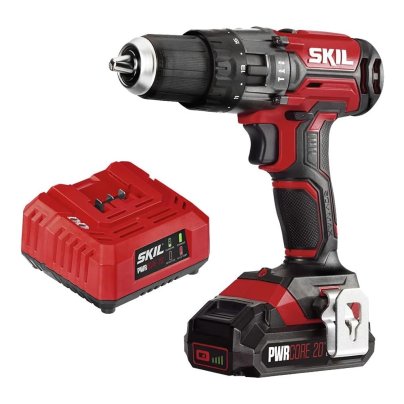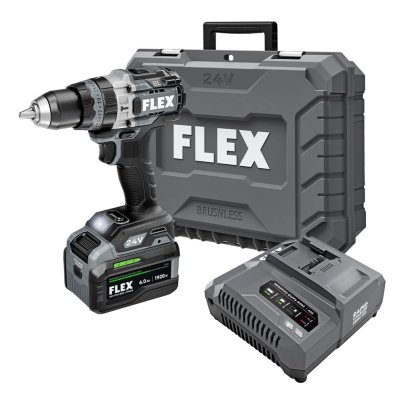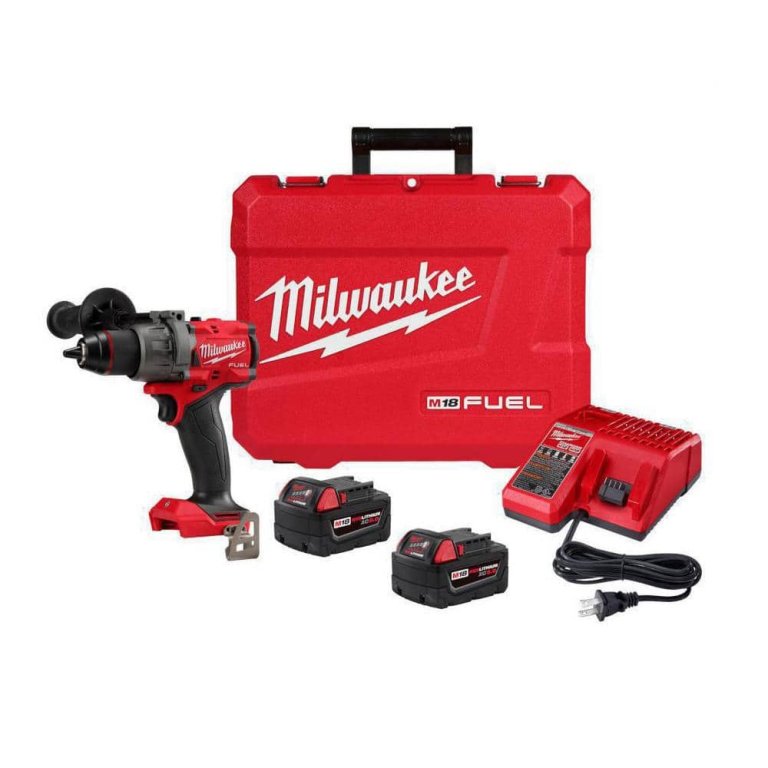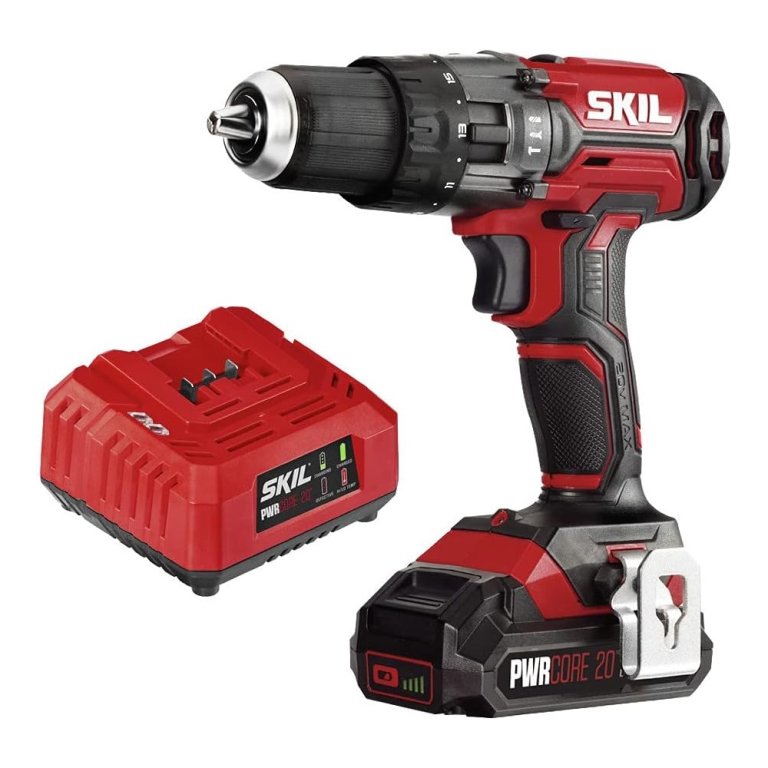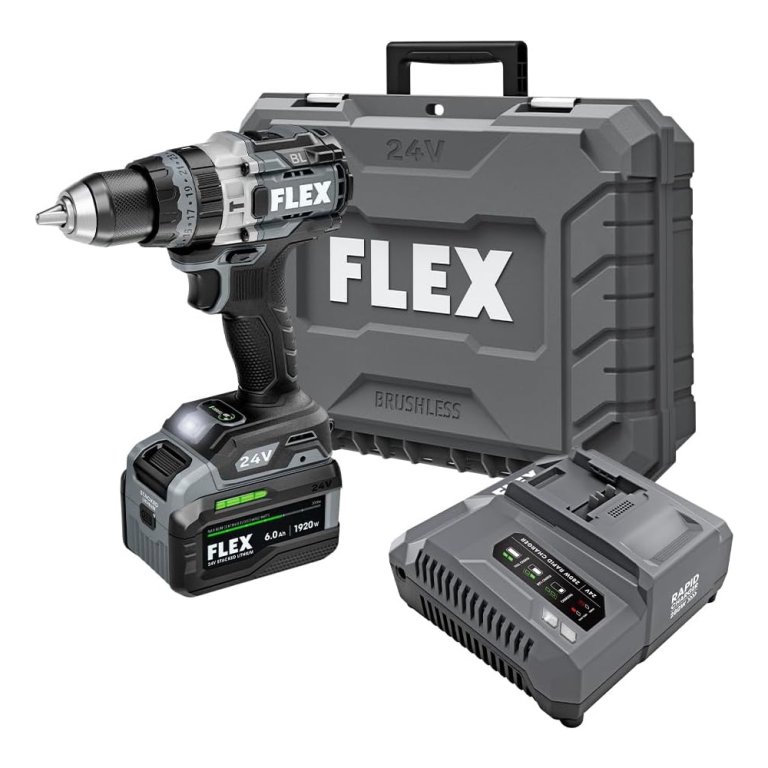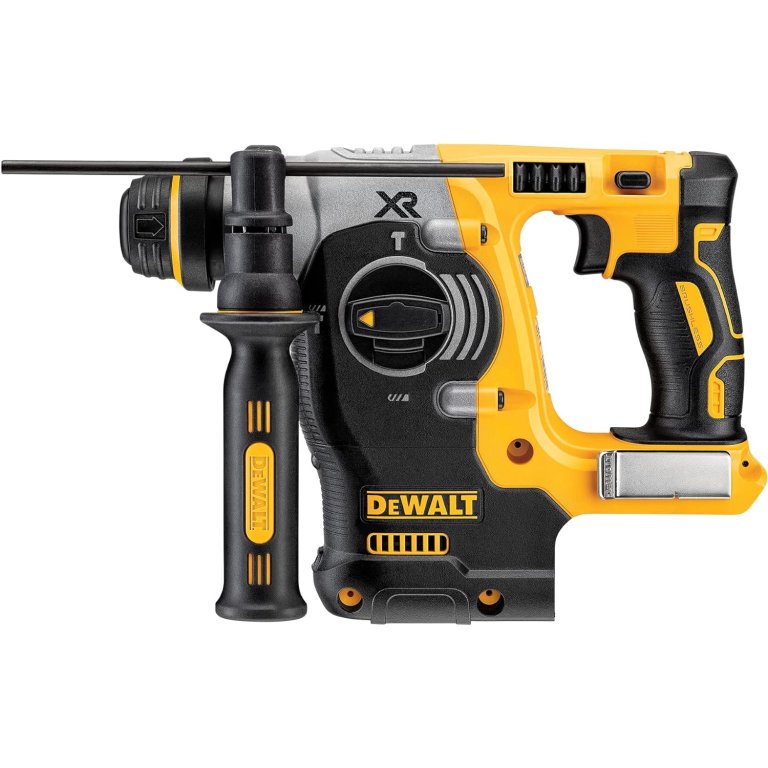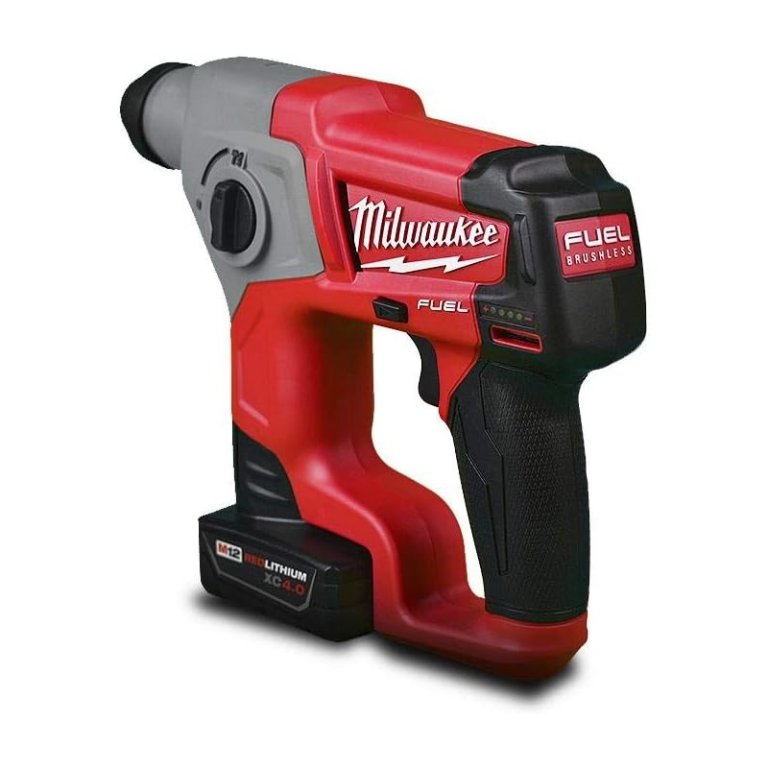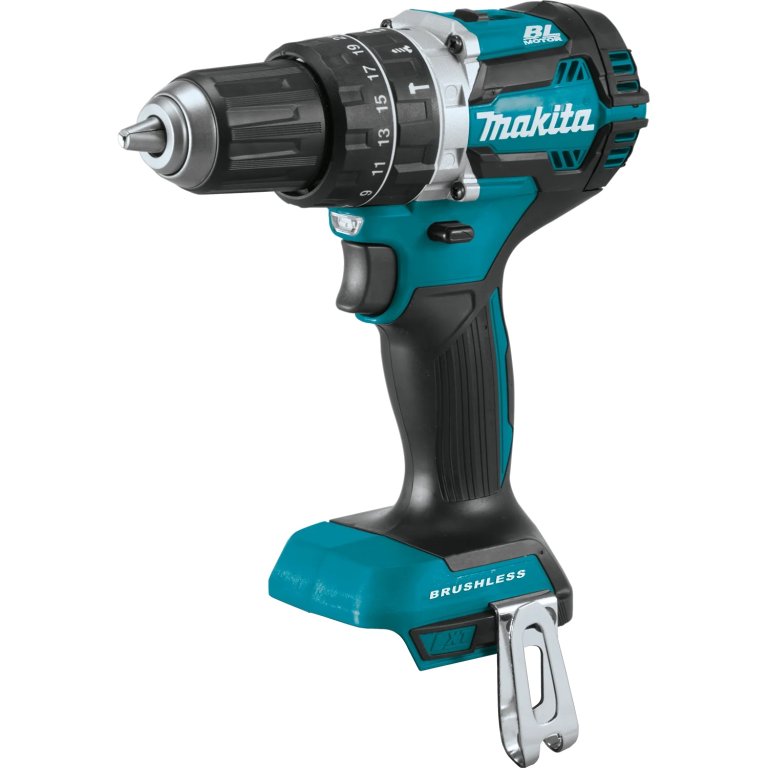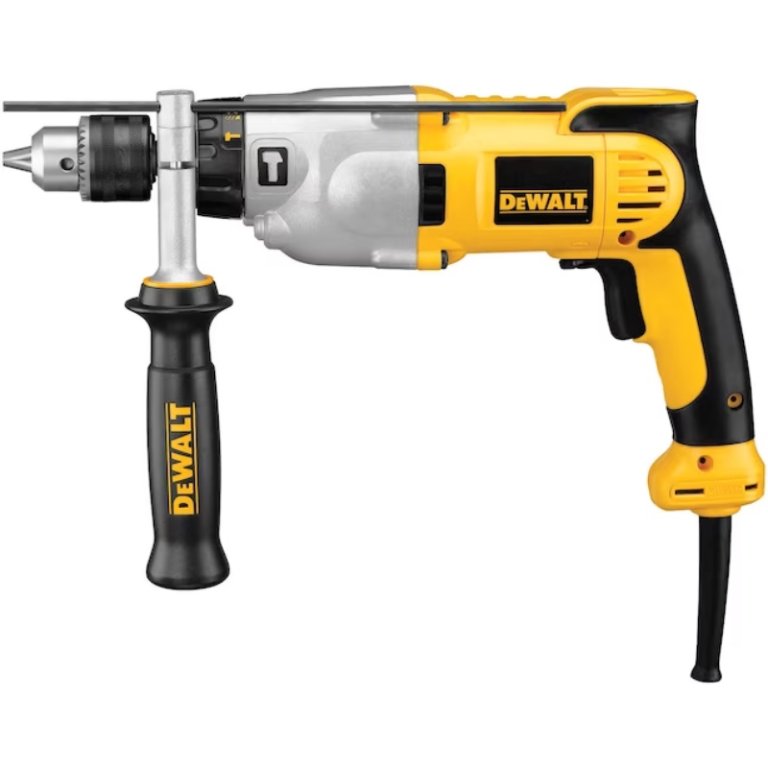
We may earn revenue from the products available on this page and participate in affiliate programs. Learn More ›
A hammer drill is a multipurpose tool that bores holes; drives screws; and drills into stone, brick, metal, and other hard materials. In residential settings, a hammer drill is typically used to make holes in walls to run wires or pipe from the outside.
Unlike cordless drills, which are more suited to basic DIY jobs, a hammer drill is meant for heavy-duty tasks. But not all hammer drills are the same. They can vary significantly in power, design, build quality, and price. We put seven hammer drills to the test in an effort to find which one tops the list when it comes to performance, ease of use, and value. With its high power-to-weight ratio, smooth operation, and top-notch build quality, Milwaukee’s M18 Fuel hammer drill gets our vote for the Best Overall pick. Read on to learn more about our test results, and to find out how to choose the best hammer drill for your specific needs.
- BEST OVERALL: Milwaukee M18 Fuel ½-Inch Hammer Drill/Driver
↓ Jump to Review - BEST BANG FOR THE BUCK: Skil Pwrcore 20 20V ½-Inch Hammer Drill Kit
↓ Jump to Review - UPGRADE PICK: Flex ½-Inch 2-Speed Hammer Drill With Turbo Mode
↓ Jump to Review - BEST CORDLESS ROTARY: DeWalt 20V MAX 1-Inch XR SDS Plus Rotary Hammer
↓ Jump to Review - BEST COMPACT: Milwaukee M12 Fuel ⅝-Inch SDS Plus Rotary Hammer Kit
↓ Jump to Review - BEST MULTIPURPOSE: Makita 18V LXT ½-Inch Cordless Hammer Driver/Drill
↓ Jump to Review - BEST CORDED: DeWalt ½-Inch VSR Pistol Grip Hammer Drill
↓ Jump to Review
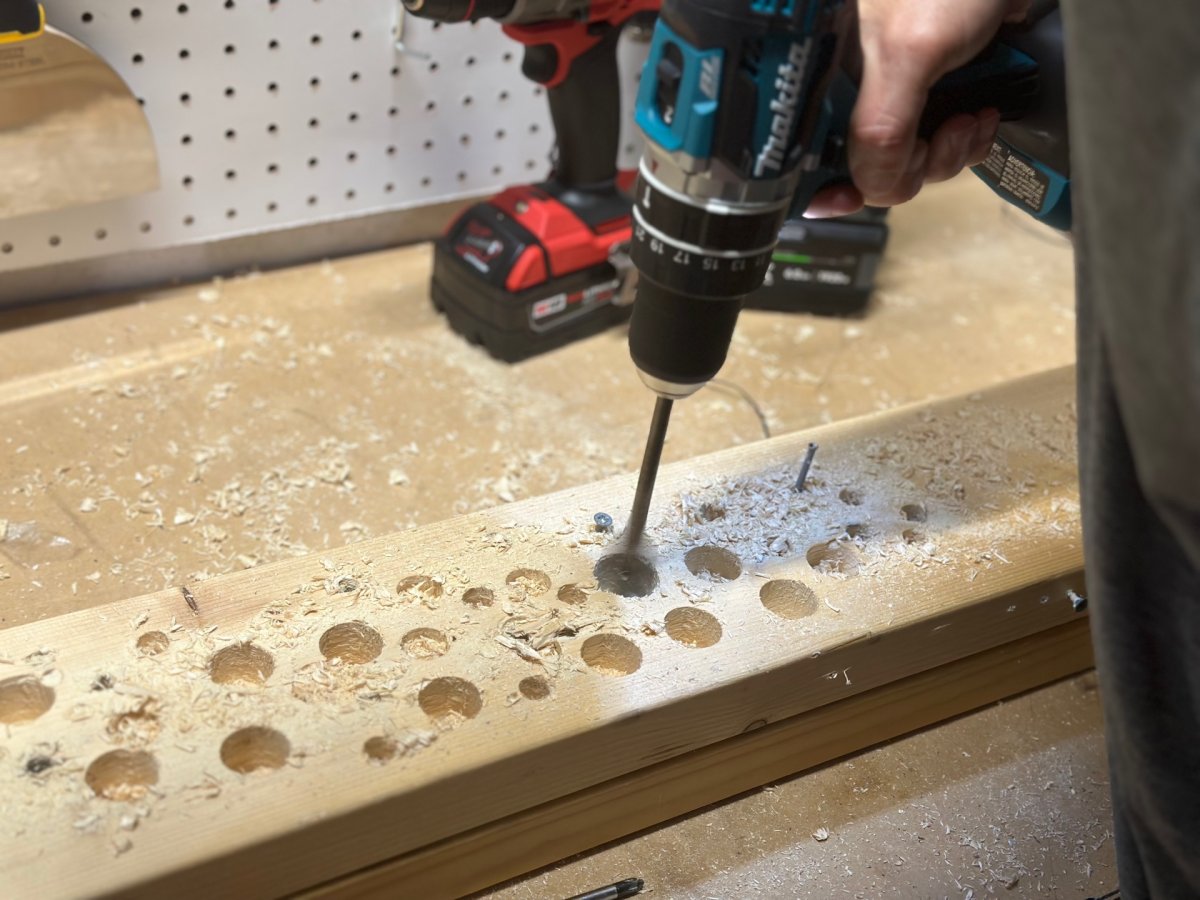
| Testing Stats | |
|---|---|
| Products tested | 7 |
| Time spent testing | 4 hours |
| Tests performed | 4 |
| Price range | $80 to $279 |
Our Top Picks
Both DIYers and professionals consider these hammer drills the best in their classes based on functionality, cost, and design.
Best Overall
Milwaukee M18 Fuel ½-Inch Hammer Drill/Driver
See ItWhat We Like
- Tremendous power-to-weight ratio
- Metal clutch and gear case
- Compact head length
- Auto shutoff helps prevent injury
What We Don’t Like
- Some customers report problems with chuck after extended use
- Comes with a premium price tag
Product Specs
- Max speed: 2,000 revolutions per minute (RPM)
- Max torque: 1,200 inch pounds (in-lbs)
- Impact rate: N/A
- Weight: 3.2 pounds
Our Ratings: Ease of Use 5/5; Ergonomics 5/5; Performance 5/5; Value 4.7/5
Milwaukee’s cordless power tools routinely come out on top, and this hammer drill is no exception. It boasts a tremendous power-to-weight ratio, producing some 1,200 in-lbs of torque and a max speed of 2,000 RPM. These impressive specs bore out in our testing. The Milwaukee had no problem making holes with our 1-inch paddle bit or ½-inch standard drill bit. It also didn’t hesitate when driving in 3-inch lag bolts. While the Flex hammer drill we tested offered similar performance, the Milwaukee Fuel was far lighter, weighing nearly 2 pounds less with battery, and it’s relatively compact for a hammer drill at about 7 inches from top to tail
Other things stood out to us as we tested the Milwaukee, including an all-metal chuck that puts a tight grip on bits, and a sturdy metal gear case cover. It also has a built-in auto-stop feature that halts the tool if it gets stuck, which helps prevent wrist injuries from over rotation.
The Milwaukee M18 Fuel hammer drill isn’t cheap. However, if you’re looking for a hammer drill that’s worthy of a spot in a pro’s tool arsenal, then it’s well worth the investment.
Get the Milwaukee M18 hammer drill at The Home Depot.
Best Bang for the Buck
Skil Pwrcore 20 20V ½-Inch Hammer Drill Kit
See ItWhat We Like
- Suitable for drilling in wood, metal, and masonry
- 3 modes: hammer drill, drill, driver
- LED light offers added illumination in low-light work situations
What We Don’t Like
- Not as powerful as the other models
Product Specs
- Max speed: 1,450 RPM
- Max torque: 177 in-lbs
- Impact rate: 21,750 blows per minute (BPM)
- Weight: 4.3 pounds
Our Ratings: Ease of Use 4.7/5; Ergonomics 5/5; Performance 4.5/5; Value 5/5
Skil has made a name for itself by producing affordably priced power tools that still pack a punch, and this hammer drill is a great example. While its low torque output and lack of a brushless motor limit it to smaller home projects, its max impact rate of 21,750 BPM makes it a very capable hammer drill for boring holes in masonry. As long as we took our time with the Skil, it was able to bore through concrete just fine.
That said, we’d limit it to jobs that require fewer than a dozen holes in masonry in succession. While the Skil did create more vibrations than other hammer drills we tested, we were still able to keep a firm grip on it. It also did a nice job of drilling clean holes through ceramic tile without cracking the surface.
At under 5 pounds, the Skil hammer drill is also lighter than most hammer drills we tested. And although its head is fairly long at nearly 8 inches, it’s still easy to handle. It has a drill and driver mode and two speed settings, making it a good choice for driving in smaller screws or drilling holes in wood. Perfect for those who need to drill through harder materials only on occasion, it’s a great budget hammer.
Get the Skil hammer drill at Amazon or Lowe’s.
Upgrade Pick
Flex ½-Inch 2-Speed Hammer Drill With Turbo Mode
See ItWhat We Like
- Produces tremendous drilling and driving power
- Good build quality with metal chuck
- Multiple ways to adjust speed and torque
What We Don’t Like
- Very heavy
Product Specs
- Max speed: 2,500 RPM
- Max torque: 1,400 in-lbs
- Impact rate: 40,000 BPM
- Weight: 6.8 pounds
Our Ratings: Ease of Use 4.3/5; Ergonomics 4/5; Performance 5/5; Value 5/5
Flex differentiates itself from the pack with a 24-volt lithium-ion battery and Turbo Mode that give it tremendous power. With its Turbo option engaged, this heavy-duty drill can reach eye-popping speeds of 2,500 RPM and a max torque of 1,400 in-lbs. All of that muscle was on display during testing. It burrowed through concrete nearly as well as our corded hammer drill pick, and it bored through two stacked 2x6s with a 1-inch paddle bit as easily as if we were drilling through butter.
And while others hesitated while driving in a 3-inch-long lag bolt, the Flex drove the fastener in under 2 seconds. In fact, we had to back off the speed to avoid overdriving the bolt head into the wood. In short, the Flex was easily the most powerful drill of the bunch. Despite all that power, the Flex never felt hard to control. Its action is so smooth with little noise or vibration that drilling these large holes and driving in oversize fasteners felt almost effortless. The Flex does come with a handle attachment, which we recommend using if you value your wrist.
There is a trade-off with the Flex, and it’s in the weight department. The Flex hammer drill weighs in at just under 7 pounds with battery and handle attachment. For reference, that’s 2 pounds heavier than our lightest entry, the Milwaukee M18. If you’re looking for the most powerful cordless hammer drill option and don’t mind the added weight, this is the one to choose.
Get the Flex hammer drill at Lowe’s or Acme Tools.
Best Cordless Rotary
DeWalt 20V MAX 1-Inch XR SDS Plus Rotary Hammer
See ItWhat We Like
- Ergonomic design and grip
- 3 modes: drill only, hammer only (chipping), or a combination of hammer and drill
- Adjustable depth-stop rod
What We Don’t Like
- Slightly heavy for repeated drilling through ceramic tile
Product Specs
- Max speed: 1,100 RPM
- Max torque: N/A
- Impact rate: N/A
- Weight: 6.8 pounds
Our Ratings: Ease of Use 5/5; Ergonomics 4.7/5; Performance 5/5; Value 4.7/5
Given DeWalt’s reputation as a premium tool brand, we weren’t surprised that it powered through our masonry-drilling tests with ease. Wanting to see what this rotary drill could really handle, we went straight to a large masonry bit. It bored through concrete with relative ease, creating a smooth hole. It did just as well drilling through concrete or functioning as a chipper, chipping grout off brick.
We particularly liked the ergonomic design of this rotary drill. Its pistol-style grip and compact shape made it easy to grip and control the tool while drilling. DeWalt’s rotary drill hammer is also a versatile tool, with a dial that allows you to set it for chipping, drilling, or hammer drilling. Though this drill is a bit large for drilling projects that require more finesse, we were still able to drill through tile without chipping the glazed surface by dialing down the speed and beats per minute.
Keep in mind that, like many rotary drills, this one requires SDS drill bits. If you have a lot of masonry to drill through and want more power than what a standard hammer drill offers, the DeWalt SDS is the way to go.
Read our full review: DeWalt 20V MAX 1-Inch XR SDS Plus Rotary Hammer
Get the DeWalt SDS hammer drill at Amazon, Ace Hardware, or Acme Tools.
Best Compact
Milwaukee M12 Fuel ⅝-Inch SDS Plus Rotary Hammer Kit
See ItWhat We Like
- Compact and lightweight enough for tight spots
- LED light is bright
- Plenty of torque for a small hammer drill
What We Don’t Like
- Doesn’t include accessory bar
Product Specs
- Max speed: 900 RPM
- Max torque: N/A
- Impact rate: 6,200 BPM
- Weight: 3.9 pounds
Our Ratings: Ease of Use 5/5; Ergonomics 5/5; Performance 4/5; Value 4.5/5
We typically think of rotary drills as power-hungry machines that demand at least an 18-volt motor and battery if not 36 volts, which is why Milwaukee’s decision to make a 12-volt model is so surprising. At least that was our opinion until we put it to the test. While this 12-volt model won’t compete with the 18-volt rotary drills we tested, it’s still a powerful little machine. We were able to bore holes into concrete, cinder brick, and tile quickly.
It’s also easier to wield than most rotary hammer drills. With its compact size and light overall weight, it fits in tighter spots than 18-volt and larger rotary hammer drills are able to reach. It also operates smoothly, with only subtle vibrations. Milwaukee’s 12-volt rotary drill’s smaller motor does limit its functionality, and unlike other rotary hammer drills, there is no chipping function.
While it may not be powerful enough for heavy use, it’s a perfect choice for electricians and plumbers who may need to drill precision holes into concrete while running wire or plumbing.
Get the Milwaukee M12 hammer drill at The Home Depot or Amazon.
Best Multipurpose
Makita 18V LXT ½-Inch Cordless Hammer Driver/Drill
See ItWhat We Like
- Lighter-than-average weight for a hammer drill
- Drills through wood and masonry well
- Star Performance tech extends tool and battery life
What We Don’t Like
- Low torque output compared to other hammer drills
Product Specs
- Max speed: 2,000 RPM
- Max torque: 530 in-lbs
- Impact rate: 30,000 BPM
- Weight: 4.1 pounds
Our Ratings: Ease of Use 4.7/5; Ergonomics 5/5; Performance 3.7/5; Value 4/5
Makita’s LXT ½-inch brushless cordless hammer drill driver is a more compact hammer drill designed for lighter-duty jobs. It can reach max speeds of 2,000 RPM with a max torque of 530 in-lbs.
As power goes, Makita’s power drill pales in comparison to the hammer drills on our list that are capable of producing nearly three times as much torque. This difference was evident during testing. While the Makita was able to handle our drilling tests with a 1-inch paddle bit into wood and standard ½-inch drill bit into concrete, it failed to drive a 3-inch lag bolt into wood, maxing out about halfway through the effort.
That’s not to say it doesn’t have its advantages. It’s lighter than most hammer drills, weighing just over 4 pounds with a 3.0-amp-hour (Ah) battery, 5 pounds lighter than the Flex hammer drill we tested, and just about a pound heavier than our best overall. At 7 inches from the tip of the chuck to the back of the head, it’s more compact than most. It also has Makita’s Star Technology, which helps extend the life of the tool and batteries by preventing them from overheating or overloading—a nice feature when drilling through concrete.
Its lightweight design makes it a good option if you’re looking for a hammer drill that’s similar in size and weight to a standard cordless drill and don’t mind the compromise in driving power.
Get the Makita hammer drill at The Home Depot or Walmart.
Best Corded
DeWalt ½-Inch VSR Pistol Grip Hammer Drill
See ItWhat We Like
- Drills quickly through masonry and wood
- Multiple drill settings
- Includes detachable side handle
What We Don’t Like
- Bulky size makes it difficult to use for smaller bits
Product Specs
- Max speed: 3,500 RPM
- Max torque: N/A
- Impact rate: 56,000 BPM
- Weight: 6 pounds
Our Ratings: Ease of Use 4.7/5; Ergonomics 4/5; Performance 4.7/5; Value 4/5
If you’re looking for max power for drilling through concrete, brick, and other masonry and don’t mind the inconvenience that comes with a cord, then consider this corded hammer drill from DeWalt. With its 10-amp motor, it can reach blazing fast speeds of 3,500 RPM.
During testing, it drilled through concrete faster than any of the cordless hammer drills we tested. Along with its hammer drill setting, it also has two drill settings, ideal for lowering the speed and torque for smaller bits when drilling into softer surfaces, such as wood. The drill also comes with a sturdy handle that’s easy to attach and detach.
The DeWalt power tools we tested are usually the toughest, and this one was no exception with its all-metal chuck and gear case. While the drill isn’t particularly heavy at 6 pounds, it is far bulkier than cordless counterparts, which makes it hard to use for smaller drilling applications that demand precision and finesse.
If you have a project that requires drilling more than a couple of holes in masonry or making large holes in wood, this corded model is a great choice.
Get the DeWalt VSR hammer drill at Lowe’s or The Home Depot.
Jump to Our Top Picks
How We Chose and Tested the Best Hammer Drills
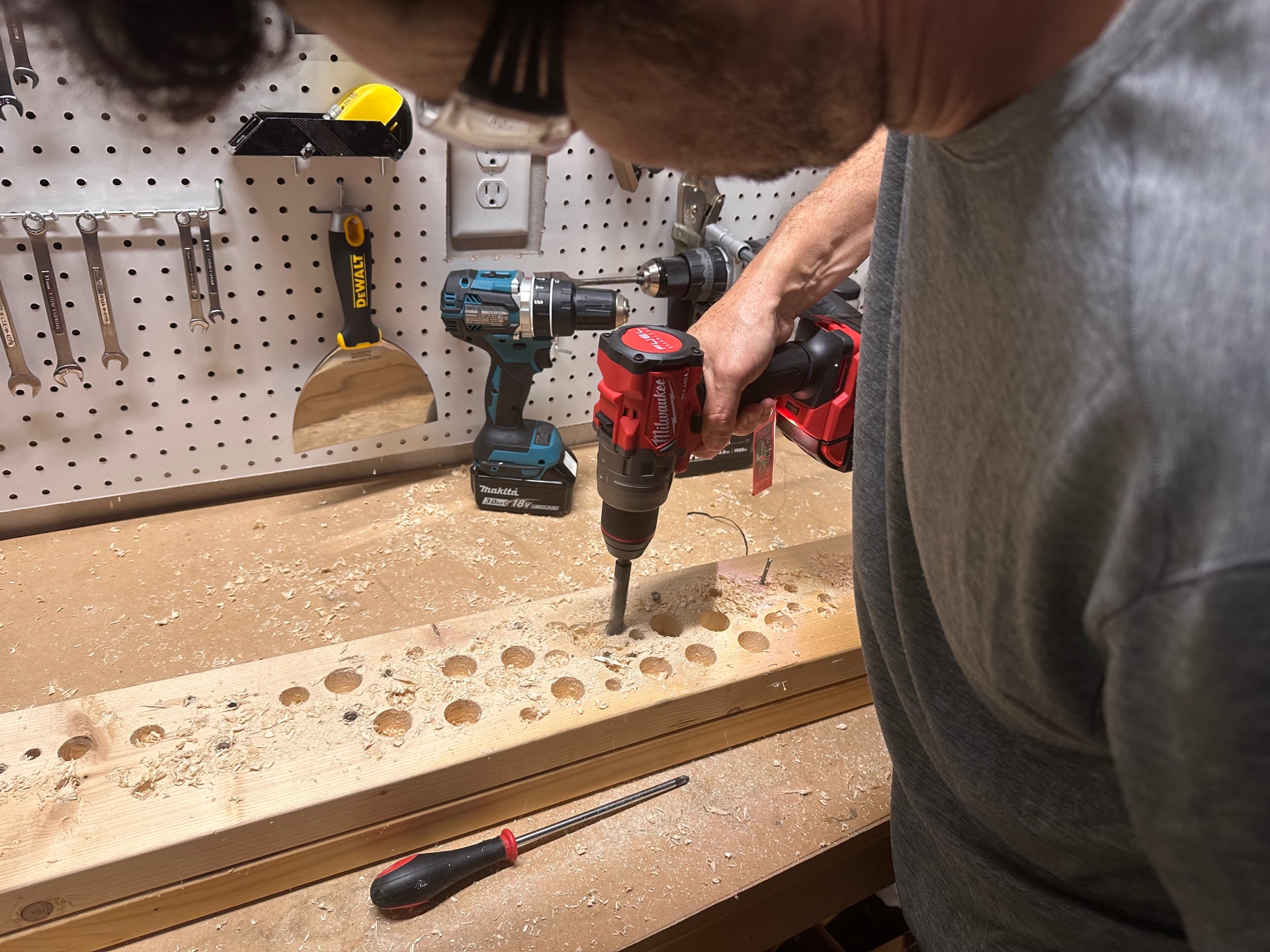
We tested the top hammer drills by putting them through a series of tests. Since hammer drills are designed mainly for drilling through masonry, we loaded each one up with an identical masonry bit and set about drilling holes in a large lump of concrete to an identical depth. We noted how quickly each one drilled through the material as well as how comfortable the tool was to use, noting weight, vibration, and the ergonomics of the grip. We also conducted similar tests on ceramic tile and concrete. Since most hammer drills have multiple functions for drilling and driving, we also tested each one’s ability to drill large holes into wood by using a 1-inch paddle bit, and drove in large fasteners by attempting to drill in a 3-inch lag bolt. After noting each hammer drill’s performance and ease of use, we also factored in price to determine each tool’s overall value.
What to Consider When Choosing the Best Hammer Drill
When you are looking for a powerful hammer drill for your next project, it’s important to consider several key factors. First, decide whether you prefer a battery-powered or a corded model, then look for one with a variable-speed trigger for better control. Even a regular drill will typically have a variable-speed trigger, so the next thing to think about is the various modes of operation. The best hammer drills can be used for hammer drilling through masonry material, drilling through softer material (like wood) and driving screws. Just make sure you have the correct drill bits for the job.
Corded vs. Cordless
Hammer drills come with one of two power source options: either a heavy-duty cord or a rechargeable battery. Corded hammer drills provide a constant source of power and also tend to be somewhat more powerful than battery-operated models—two aspects that make them more effective and dependable for long days on a busy jobsite. They can be plugged into an extension cord if needed for a longer reach, but corded hammer drills are ultimately tethered to a nearby source of electricity.
Conversely, a cordless hammer drill is bound to run out of juice after several hours of use, but these models do have their strong points. They’re generally lighter, smaller, and easier to maneuver than their corded counterparts (plus there’s no chance of tripping over that pesky power cord). Cordless models tend to be more popular with DIYers, who appreciate their portability and versatility for projects around the house.
Variable Speed
Different jobs often require a drill to run at faster or slower speeds to improve accuracy and penetration, while avoiding any damage to the drill itself. A good hammer drill will feature either a variable-speed-setting dial or a trigger control that lets you adjust the operating speed. To determine if a drill has a variable-speed setting, look for a dial that shows the numbers from 1 to 2, or sometimes 1 to 3, with 1 being the lowest setting.
A trigger control, which responds to the amount of pressure you apply, offers a greater degree of speed control. Some prefer this personalized control, while others want a drill to operate at the same speed all the time. A trigger control tends to be most beneficial when the user doesn’t have a free hand to adjust the speed—one reason trigger controls are preferred by professionals.
Hammer Mode
The hammer mode is a setting on all hammer drills that’s commonly marked by a symbol depicting a hammer. This mode introduces a pulsating action that helps drive masonry bits through hard materials, such as concrete, brick, and stone.
In addition to the increased hammering force, the drill maintains its rotational capabilities to drill and punch through hard material, similar to combining an auger and a jackhammer, though to a lesser degree. Rotary hammer drills are specifically made for long periods of tough jackhammering through mortar, brick, and stone.
Drill Mode
Hammer drills commonly have a button that allows the user to switch between the hammer mode and normal operation. This is generally referred to as drill mode and may be marked only by a variable-speed setting ranging from 1 to 3.
Alternatively, it may be marked by a symbol that resembles a drill bit, depending on the model. This mode has more controlled torque and is intended for drilling holes through softer materials, such as wood or plastic.
Drive Mode
Some hammer drills (as well as regular drills) feature a setting called a drive mode, which is used for driving and removing screws. Drive mode eliminates the pulsating force of the hammer setting and instead engages the torque-adjustment setting for precision work like driving screws into a deck.
This low-power setting helps ensure that the torque of the drill won’t strip the screws. A hammer drill with drive mode will often show a symbol that resembles a screw on the mode-control switch.
Additional Features
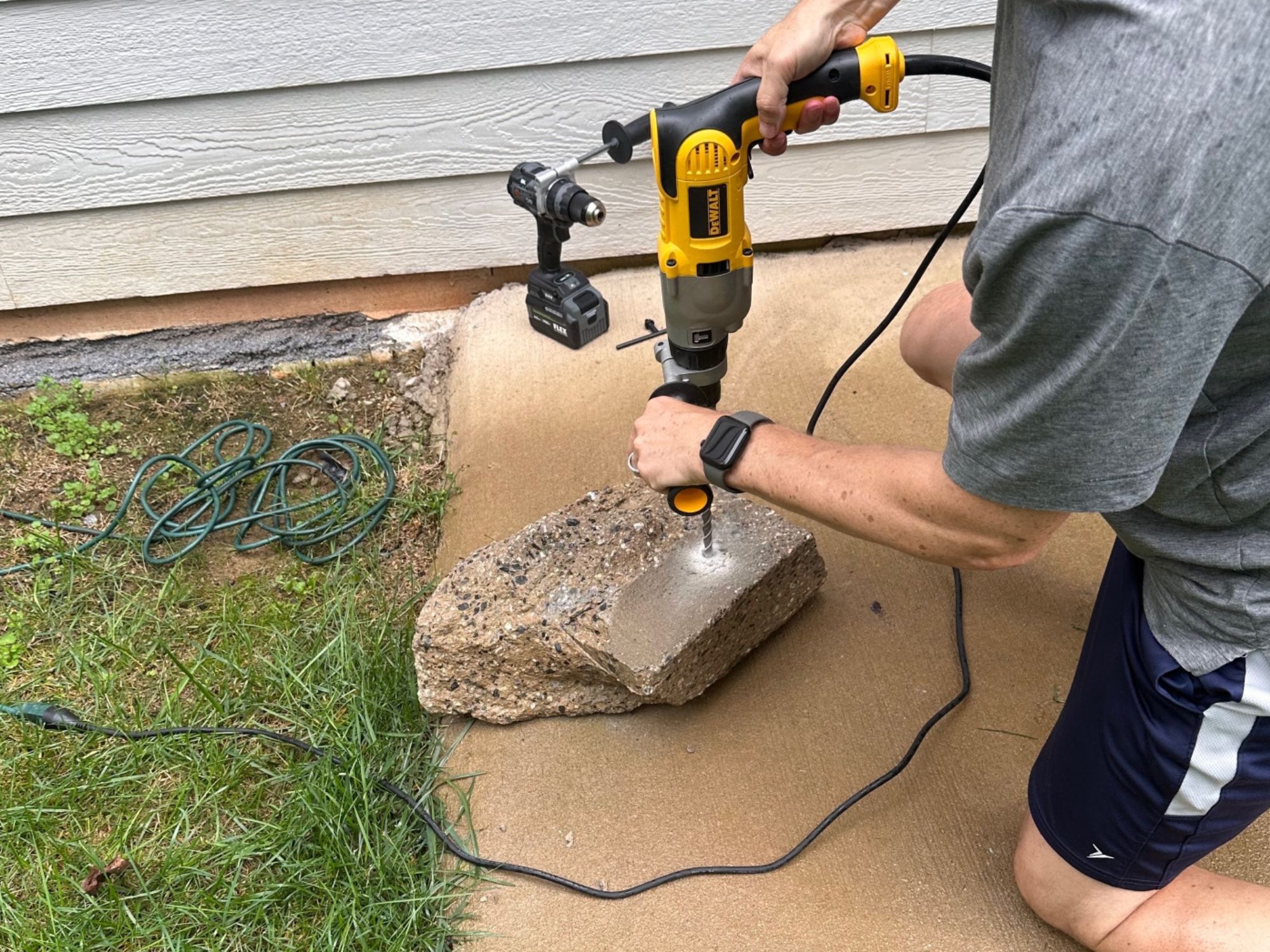
Higher-end hammer drills may offer extra features that can help the user complete a project faster or add a touch of comfort or functionality. These options can include a 360-degree auxiliary handle, a built-in flashlight, a depth gauge, a brushless motor, a carrying case, or a spare battery.
- 360-degree auxiliary handle for the best grip possible in complex or enclosed spaces.
- Built-in flashlight to help users see what they are doing without needing to hold a separate light source.
- Depth gauge to determine how deep a hole has been drilled. This simple tool just needs to be inserted into the hole and the reading on the edge of the gauge will indicate the depth of the hole.
- Brushless motors, as the name implies, do not have brushes inside the motor to reverse the polarity of the electromagnet. Instead, the motor has a different configuration that allows it to reduce the heat produced by the drill while increasing the life of the tool.
- Carrying cases are effective for carrying the hammer drill when it’s not in use and are also used for simple storage.
- Spare batteries may not be necessary for corded hammer drills, but it’s always good to have a backup battery on hand when you are working with a cordless hammer drill.
FAQs
Even after selecting a new hammer drill for your workshop, you may have additional questions. Take a look below to find the answers to several commonly asked questions about the capabilities of a hammer drill, the difference between a hammer drill and a regular drill, the average life of a hammer drill, and more.
Hammer drills are primarily designed for light masonry work. The added hammer function allows them to impact harder materials, like mortar and brick, while the rotational force drives a neat drill hole through the material.
The main difference between a regular drill and a hammer drill is that a regular drill can only rotate the drill bit. A hammer drill, as the name indicates, has a hammering motion that impacts the target material with the tip of the drill bit. At the same time, the drill bit is rotating, allowing the combination of forces to drive through tough mortar, brick, and concrete.
A hammer drill bit or a masonry bit can be used in a regular drill, though you may have difficulty drilling large-diameter holes through concrete and other tough material with a regular drill.
With the right drill bit, you can use a hammer drill to drill through rebar, though it may take some time. If you are regularly dealing with rebar, it may be better to consider using a rotary hammer drill.
A hammer drill will typically last about 5 to 10 years, depending on the frequency of use and the level of care taken during routine maintenance.
Since hammer drills are designed specifically to drill into concrete, most drills with a hammer function will work as a hammer drill for concrete. That said, if you’re looking for maximum drilling power for boring into masonry, go with a rotary hammer drill.
Whether or not a hammer drill is worth buying depends on your needs. If you find yourself drilling into masonry on a fairly regular basis, then a good hammer drill is a worthwhile investment. Since many hammer drills also function as a standard drill/driver, purchasing a hammer drill to fulfill all your drilling and driving needs as opposed to a standard drill/driver might also make sense.
Meet the Testers
Tony Carrick is a freelance writer specializing in home improvement, landscaping, technology, home security, and design for such sites and publications as Popular Mechanics, Pro Tools Review, CNN Underscored, and This Old House Magazine.
Glenda Taylor is a product tester and writer specializing in the construction, remodeling, and real estate industries. She tests a wide range of power tools as well as other home improvement, household, and lawn-and-garden products.
Additional research provided by Timothy Dale.

